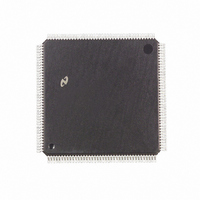DP83953VUL National Semiconductor, DP83953VUL Datasheet - Page 17

DP83953VUL
Manufacturer Part Number
DP83953VUL
Description
IC CTRLR RIC REPEATER 160-PQFP
Manufacturer
National Semiconductor
Datasheet
1.DP83953VUL.pdf
(90 pages)
Specifications of DP83953VUL
Controller Type
Ethernet Repeater Interface Controller
Interface
IEEE 802.3
Voltage - Supply
4.75 V ~ 5.25 V
Current - Supply
870mA
Operating Temperature
0°C ~ 70°C
Mounting Type
Surface Mount
Package / Case
160-MQFP, 160-PQFP
Lead Free Status / RoHS Status
Contains lead / RoHS non-compliant
Other names
*DP83953VUL
Available stocks
Company
Part Number
Manufacturer
Quantity
Price
Company:
Part Number:
DP83953VUL
Manufacturer:
HJC
Quantity:
2 010
Company:
Part Number:
DP83953VUL
Manufacturer:
Texas Instruments
Quantity:
10 000
4.0 Functional Description
The Port State Machine (PSM)
The two primary functions of the PSM are to:
1. Control the transmission of repeated data, pseudo ran-
2. Determine if a port will be the source of data or collision
The Main State Machine (MSM)
The MSM controls the operation of the shared functional
blocks in each RIC2A as shown in the block diagram,
Figure 1, and performs the majority of the data and colli-
sion operations as defined by the IEEE specification.
The interaction of the main and port state machines is visi-
ble, in part, through the Inter-RIC bus.
Preamble
Regeneration
Fragment
Extension
Elasticity Buffer
Control
Jam / Preamble
Pattern Genera-
tion
Transmit
Collision
Enforcement
Data Encoding
Control
Tw1
Enforcement
Tw2
Enforcement
dom data, and jam signals over the attached segments.
information to be repeated over the network. This repeat-
er port is known as PORT N . An arbitration process is re-
quired to enable the repeater to transition from an IDLE
state to the SEND PREAMBLE PATTERN or RECEIVE
COLLISION states. (See Figure 4) This process is used
to locate the port that will be PORT N for that particular
packet.The data received from PORT N is directed to the
PLL decoder and transmitted over the Inter-RIC bus. If a
collision occurs, the repeater enters the TRANSMIT
COLLISION state. Then a subsequent arbitration opera-
tion is performed in order to determine which port is
PORT M . PORT M is differentiated from the repeater’s
other ports if the repeater enters the ONE PORT LEFT
state. In this state PORT M does not transmit to its seg-
ment. At that time, all other ports are still required to
transmit to their segments.
Function
Restore the length of the preamble pat-
tern to the defined size.
Extend received data or collision frag-
ments to meet the minimum fragment
length of 96 bits.
A portion of the received packet may re-
quire storage in an Elasticity Buffer to
accommodate preamble regeneration.
In cases of receive or transmit colli-
sions, a RIC2A is required to transmit a
jam pattern (1010...).
Note: This pattern is the same as that used for pre-
amble regeneration.
The TRANSMIT COLLISION state re-
quires a repeater to remain in this state
for at least 96 bit times.
NRZ formatted data in the elasticity
buffer must be encoded into Manches-
ter formatted data prior to re-transmis-
sion.
Enforce the Transmit Recovery Time
specification.
Enforce Carrier Recovery Time specifi-
cation on all ports with active collisions.
Action
(Continued)
17
Inter-RIC Bus (IRB) Operation
Overview
The IRB consists of eight signals. These signals implement
a protocol that may be used to connect multiple RIC2As
together. In this configuration, the logical function of a sin-
gle repeater is maintained. The resulting multi- RIC2A
repeater system is compliant with the IEEE 802.3 Repeater
Specification and may even encompass several hundred
network segments. Figure 5 shows an example of a multi-
port RIC2A system.
www.national.com











